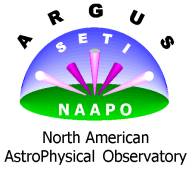Beyond the Big Ear
OSU researchers rethink how to listen for life out there
Tuesday, April 20, 2004
Mike Lafferty
THE COLUMBUS DISPATCH
It used to be that those who wanted to know if anything or anyone was "out there" simply looked toward the heavens.
Gods, heroes and animals filled the sky.
The Roman god Apollo charged across the sky in a fiery chariot.
Hindus believed seven sages known as the Rishis were the stars of what is now called the Big Dipper.
What we call the Milky Way was the mystical road to the Mayan Indians’ underworld.
Optics and telescopes eventually turned gods into stars, planets and galaxies. Still, humans have never stopped wondering whether we are alone.
The twin NASA rovers are just the latest to search for life among the stars.
It’s one thing to look for life. Listening is a whole other ballgame.
Listening for life
Maybe, just maybe, some intelligent civilization not unlike ours is leaking its telltale radio, television or other electromagnetic emissions into the heavens.
A small group of scientists and engineers has established a listening post off Kinnear Road on the Ohio State University campus.
 Credit: The Columbus Dispatch
Credit: The Columbus Dispatch
|
Called Project Argus, it is the successor to Ohio State’s fabled Big Ear radio telescope in Delaware County, which for 20 years was the world’s longest-dedicated search for alien life. It was demolished for a housing project and a golf course expansion in 1998.
"This is probably one of the most long-range and profound problems our civilization has," said Robert Dixon, who heads the new search.
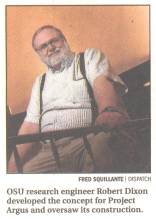 Photo Credit: Fred Squillante; The Columbus Dispatch
Photo Credit: Fred Squillante; The Columbus Dispatch
Caption: OSU research engineer Robert Dixon developed the concept for Project Argus and oversaw its construction.
|
Argus is a collection of 32 small, white boxes mounted on the roof of the satellite-reception building — a bunkerlike structure behind the Electrosciences [ElectroScience] Laboratory. Each box holds a coiled antenna that receives electromagnetic signals from space.
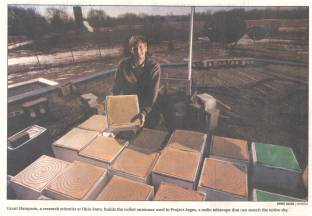 Photo Credit: Renee Sauer; The Columbus Dispatch
Photo Credit: Renee Sauer; The Columbus Dispatch
Caption: Grant Hampson, a research scientist at Ohio State, builds the [built some of the] electronics for the coiled antennae used in Project Argus, a radio telescope that can search the entire sky.
|
Dixon’s day job as a research engineer investigating new computing technologies dovetails perfectly with his obsession because radio astronomy increasingly depends on sophisticated computers and software.
"We want to start a search for transient (signals), which could come from another civilization," Dixon said. "Or it could come from some previously unknown astronomical phenomenon like an exploding star, collisions or explosions of astronomical objects or things that we can’t even imagine."
The more antennae, the more detail Argus can hear.
"We would like to expand to 64 and maybe in the near future to 1,024. If we get to 1,024, we can do some very serious astronomical and SETI (Search for Extraterrestrial Intelligence) work," he said.
The coil antennae are wired together and connected to a receiver in the satellite-receiving building. There, the signals are converted to a digital format and analyzed by computers.
The emphasis now is on fine-tuning the machinery.
"Lately we’ve been making images of the sky, of GPS (global-positioning system) signals," said Grant Hampson, a researcher in the Electrical Engineering Department.
The idea is to compare the known background to foreign signals. It’s routine stuff, but necessary so that the searchers will know if and when someone or something does say "hello."
"It’s very difficult to distinguish between something that comes from space and something we’re making here. You have to question everything," Hampson said.
Argus is low budget. Volunteers make the box mounts.
"Some of the antennae haven’t done so well. They get water in them and explode," Hampson said. [Actually, they don't "explode". Some of the boxes have come apart (e.g., a side has fallen out due to the glue not holding properly).]
Searching for another 'Wow!'
While Argus has been searching for about eight months, Dixon has been tuned in for decades.
His love affair with the airwaves began with his boyhood interest in ham radio. That led to a degree in astronomy [Actually, Bob's undergraduate degree is in electrical engineering from the University of Wisconsin.], a doctorate in electrical engineering at Ohio State and a stint with Project Cyclops, a NASA program that developed the requirements still used in the search for extraterrestrial life.
That got him hooked and pointed toward a life in SETI.
Dixon returned to Ohio State ready to mount a search with Big Ear. Electrical engineer John Kraus built the scope in 1965 near Perkins Observatory, south of Delaware.
The antenna was as large as three football fields. For seven years, Big Ear (in its Ohio Sky Survey project) searched for newly discovered deepspace radio sources [some of which were] known as quasars. By 1972, Big Ear had recorded more than 20,000 quasars [Note. Only some of the 20,000 radio sources detected were quasars].
With the quasar (Ohio Sky Survey) project ending, Dixon persuaded Kraus to turn Big Ear into a full-time SETI scout.
The problem was where to look.
Everything emits an electromagnetic signal or signature. This is why astronomers measure radiation from a planet or other objects to learn about their chemical composition. An observer on a far-off planet would be able to measure the radiation Earth emits and learn that it contains hydrogen, oxygen, carbon and other elements and chemicals.
Each of these chemical signals occupies a distinct portion of the spectrum. Because hydrogen is the most abundant element in the universe and is a key ingredient of water, the OSU team chose the hydrogen spectrum as its target.
If extraterrestials think the same way as SETI researchers, they might choose that common hydrogen spectrum to manufacture a beacon signal.
The trick is in differentiating the signal from the surrounding hydrogen noise. "As soon as somebody puts something stronger than the hydrogen in, you hear it," Hampson said.
Big Ear recorded the only signal from space that made scientists sit up and really wonder. At 11:16 p.m. on Aug.15, 1977, a monitoring computer recorded a 70-second burst.
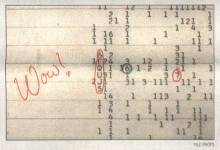 Photo Credit: File Photo; The Columbus Dispatch
Photo Credit: File Photo; The Columbus Dispatch
Caption: A 70-second burst that came to be known as the "Wow!" signal.
|
When he noted it, SETI volunteer Jerry Ehman wrote "Wow!" in the margin of the recording paper.
 Photo Credit: File Photo; The Columbus Dispatch
Photo Credit: File Photo; The Columbus Dispatch
Caption: Jerry Ehman, photographed in front of the Big Ear radio telescope in 1995, detected a 70-second burst that came to be known as the "Wow!" signal. Big Ear was demolished in 1998. Project Argus is its successor.
|
The name stuck, and scientists have been unable to find anything like it since.
Small antenna, big target
Argus takes advantage of computer and antenna advances that allow for a greater punch. Unlike Big Ear, engineers do not have to aim Argus at anything in particular.
The idea is to make a large antenna from a lot of small antennae.
"It can see the whole sky all the time," Dixon said.
The data can be stored for later analysis and data can be massaged to allow a scientist to tune in on very precise parts of the sky.
"This is the future," Dixon said.
While tuning into a narrow band might record a faint signal in a specific range, continuously scanning the entire sky is like a lighthouse beacon sweeping for signals.
A $125,000 grant from the SETI Institute in Mountain View, Calif., got Argus going, and Dixon has subsidized the work out of his pocket, said Kent Cullers, director of research and development for the SETI Institute. [Other volunteers and some of the general public have also contributed financially to the support of Argus.]
Cullers said SETI experts were dubious of Dixon’s ideas at first.
"Bob Dixon developed the concept when it seemed absurd. We never realized there would be enough computing power," Cullers said.
Argus will truly come of age when computing power grows to allow thousands or even millions of antennae to be linked.
"It will be a really interesting instrument in a decade. As soon as it can tie 1,000 elements together, it can search for signals never looked for before," Cullers said.
Until then, the SETI Institute is relying on the Allen radio telescope, an array of dish antennae being built at Hat Creek in California.
A 32-dish array will be online by the end of the year. The full complement of 320 dishes is scheduled to be operating by 2007. The telescope, however, can only scan one part of the sky at a time.
Needle in a haystack
Even with the most advanced technology conceivable, the likelihood of finding something is excruciatingly small.
One way to look at it is from the reverse. Say aliens might have been searching for a billion years for signs of other life in the universe.
If so, they wouldn’t have found any signs from Earth before the past 50 years, and only if it was concentrating on our little galaxy.
So why search?
"Still it’s worthwhile because the payoff is so huge," said Lawrence Krauss, a physicist at Case Western Reserve University in Cleveland.
Logic, Dixon said, dictates we are not alone in the universe. "I think it would be stranger if they weren’t there."
And if aliens are never found, then the question of why life only evolved on Earth needs to be answered, he said.
mlafferty@dispatch.com
Copyright © 2004, The Columbus Dispatch
|
|
Sidebars
The Electromagnetic Spectrum
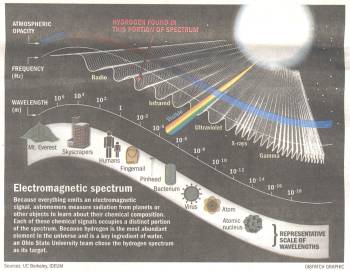
SETI facts
- The United States is the leading SETI@Home contributor. More than 2 million volunteers have donated 965,000 computer years to analyze nearly 606 million results.
- 1960: American radio astronomer Frank Drake used the radio telescope at Green Bank, W.Va., to try to detect interstellar radio signals.
- At about 4 light years away, Alpha Centauri is the closest star to Earth. A radio signal would take four years to travel to Earth.
- More than 800 million results have been returned to SETI@Home.
Argus facts
- Argus is named after the mythological guard dog that had 100 eyes and could watch in all directions.
- Of the approximately 50 radio telescopes in the world involved in SETI, Argus will be the only one monitoring the entire sky.
- The more antennae, the more coverage. Argus has 32 antennae now. More than 1,000 antennae will be needed to make Argus a useful radio telescope 100 times more sensitive.
- Computer processing may have to be 1 million times better to make a full-scale Argus array feasible, an improvement, experts say, that could very well be achieved in the next 30 years.
Signal from space?
 The nearest thing to an extraterrestrial radio signal that has ever been detected was observed by Ohio astronomers on Aug. 15, 1977. On that date Jerry Ehman, then a professor at Ohio State University in Columbus, [actually, at that time, he was employed elsewhere but was a volunteer radio astronomer at the Big Ear] noted the signal's power by writing "Wow!" in the column of a computer printout produced by Ohio SETI, a search for extraterrestrial intelligence that has been running since 1974.
The nearest thing to an extraterrestrial radio signal that has ever been detected was observed by Ohio astronomers on Aug. 15, 1977. On that date Jerry Ehman, then a professor at Ohio State University in Columbus, [actually, at that time, he was employed elsewhere but was a volunteer radio astronomer at the Big Ear] noted the signal's power by writing "Wow!" in the column of a computer printout produced by Ohio SETI, a search for extraterrestrial intelligence that has been running since 1974.
The printout gives the strength of the signal detected by a radio telescope, with the scale running from 1 through 9, and then from A to Z (as a multiple of the background noise; i.e., the number of standard deviations). The "Wow!" signal got as high as U [equivalent to 30 times the noise background] before disappearing, never to be seen again. Astronomers doubt that it really was a signal from extraterrestrials, but it looks very much as they imagine one would.
It takes time to spread the news
When astronomers search for extraterrestrial radio signals, they have to consider the amount of time it would take them to get here from wherever they originated.
For example, the radio signals carrying early television shows, such as I Love Lucy, have been traveling through space at the speed of light for 50 years, but they've only reached a few dozen of the nearest stars.
Here's how long it will take this week's episode of CSI: Crime Scene Investigation to reach some well-known celestial landmarks:
| LANDMARK | TIME |
|---|
| Moon | 1 second |
| Sun | 8 minutes |
| Mars | 12.5 minutes |
| Jupiter | 40 minutes |
| Pluto | 5.5 hours |
| Alpha Centauri (the nearest star) | 4 years |
| Center of Milky Way (our galaxy) | 30,000 years |
| Andromeda (the nearest galaxy) | 2 million years |
Sources: Robert Dixon, Ohio State University; Knight Ridder Tribune
THE COLUMBUS DISPATCH; April 20, 2004
|
